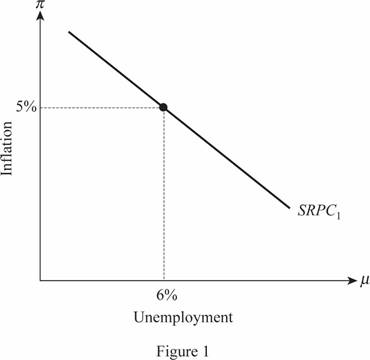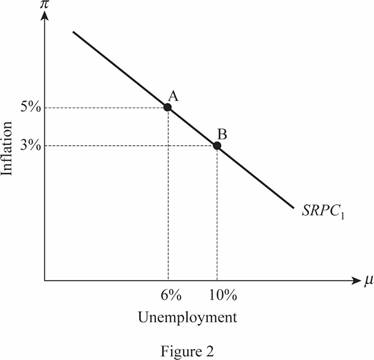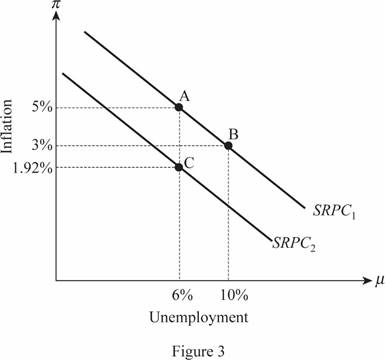
(a)
The natural rate of
(a)
Explanation of Solution
The
Here, the people make their expectations about inflation on the basis of the weighted average of the past two year's inflations. When the inflation rate is stable at 5 percent, it means that the actual inflation is same as the expected inflation and so,
Natural Rate of Unemployment: The natural rate of unemployment is the rate of unemployment that is persisting in the economy when the labor market of the economy is in its equilibrium.
(b)
The short run trade-off between the inflation and unemployment.
(b)
Explanation of Solution
The Phillips curve of the economy is given to be

Thus, the short run trade-off between the inflation which is stable at 5 percentage point and the unemployment which is at its natural rate of 6 percentage point is indicated at point A.
(c)
The impact of fall in aggregate demand short run trade-off between the inflation and unemployment.
(c)
Explanation of Solution
The Phillips curve of the economy is given to be
When the unemployment in the economy rises by 4 percentage points and becomes 10 percentage, the impact on the Phillips curve will be different because the expected inflation in the economy does not change. Thus, the Phillips curve determined the inflation rate and this can be calculated as follows:
Thus, the point B that indicates the change in the trade-off between the unemployment and inflation in the economy which will be on the same short run Phillips curve and can be illustrated as follows:

(d)
The economy during higher unemployment and after 2 years at natural rate for 10 years.
(d)
Explanation of Solution
The Phillips curve of the economy is given to be
When the unemployment in the economy rises by 4 percentage points and becomes 10 percentage, the impact on the Phillips curve will be different because the expected inflation in the economy does not change. Thus, the economy's inflation rate will be 3%. The unemployment rate, inflation rate, expected inflation rate, and the rate of output growth for the 10 years can be calculated in the following table:
| Year | Unemployment Rate | Inflation Rate | Expected Inflation Rate | Rate of Output Growth |
| 1 | 6 | 5 | 5 | 3 |
| 2 | 6 | 5 | 5 | 3 |
| 3 | 10 | 3 | 5 | −5 |
| 4 | 10 | 1.6 | 3.6 | 3 |
| 5 | 6 | 2.02 | 2.02 | 11 |
| 6 | 6 | 1.89 | 1.89 | 3 |
| 7 | 6 | 1.93 | 1.93 | 3 |
| 8 | 6 | 1.92 | 1.92 | 3 |
| 9 | 6 | 1.92 | 1.92 | 3 |
| 10 | 6 | 1.92 | 1.92 | 3 |
(e)
The impact of fall in aggregate demand short run trade-off between the inflation and unemployment.
(e)
Explanation of Solution
The Phillips curve of the economy is given to be
When the unemployment in the economy rises by 4 percentage points and becomes 10 percentage, the impact on the Phillips curve will be different because the expected inflation in the economy does not change. Thus, the Phillips curve determined the inflation rate and this can be calculated as follows:
Thus, the point B that indicates the change in the trade-off between the unemployment and inflation in the economy will be on the same short run Phillips curve. When the unemployment rate falls, the expected inflation rate would fall in the economy. This leads to the downward shift in the short run Phillips curve in the economy. From the table above, it is identified that the expected inflation rate in the economy at the end of the 10th year is 1.92 percent but the unemployment rate is 6 percent. This combination is illustrated at the point C as follows:

(f)
Before recession and after recession equilibrium.
(f)
Explanation of Solution
The Phillips curve of the economy is given to be
After recession, equilibrium is indicated at point C where the inflation rate is 1.92 and the unemployment rate is 6 percentage points. This indicates that the inflation in the economy has been decreased by 3.08 percent points in the economy. While looking at the table for the rate of growth of output, it is identified that there were a loss of 8 percent during from year 2 to year 3, whereas there were a gain of 8 percent from year 3 to year 4. From year 5 to 10, the rate of output growth remained the same which means that there is no long run sacrifice in reducing the inflation rate by the economy.
Want to see more full solutions like this?
Chapter 14 Solutions
Macroeconomics (Cloth) (Instructor's)
- agrody calming Inted 001 and me 2. A homeowner is concerned about the various air pollutants (e.g., benzene and methane) released in her house when she cooks with natural gas. She is considering replacing her gas oven and stove with an electric stove comprising an induction cooktop and convection oven. The new appliance costs $900 to purchase and install. Capping the old gas line costs an additional $150 (a one-time fee). The old line must be inspected for leaks each year after capping, at a cost of $35 for each inspection. a. If the homeowner plans to remain in the house for four more years and the discount rate is 4%, what is the minimum present value of the benefits that the homeowner would need to experience for this purchase to be justified based on its private net sub present value? b. While trying to understand how she might express the value of reduced exposure to indoor air pollutants in dollar terms, the homeowner consulted the EPA website and found estimates provided by…arrow_forwardAfter the ban is imposed, Joe’s firm switches to the more expensive biodegradable disposable cups. This increases the cost associated with each cup of coffee it produces. Which cost curve(s) will be impacted by the use of the more expensive biodegradable disposable cups? Why? Which cost curve(s) will not shift, and why not? Please use the table below to answer this question. For the second column (“Impacted? If so, how?”), please use one of the following three choices: No shift; Shifts up (i.e., increases: at nearly any given quantity, the cost goes up); or Shifts down (i.e., decreases: at nearly any given quantity, the cost goes down). $ Cost Curve Impacted? If so, how? Explanation of the Shift: Why or Why Not AFC No shift. Fix costs stay the same, regardless of quantity. Fixed cost is calculated as Fixed Cost/Quantity. Since fixed costs remain unchanged, AFC stays the same for each quantity. MC Shifts up. Since the biodegradable cups are more expensive, the…arrow_forwardStyrofoam is non-biodegradable and is not easily recyclable. Many cities and at least one state have enacted laws that ban the use of polystyrene containers. These locales understand that banning these containers will force many businesses to turn to other more expensive forms of packaging and cups, but argue the ban is environmentally important. Shane owns a firm with a conventional production function resulting in U-shaped ATC, AVC, and MC curves. Shane's business sells takeout food and drinks that are currently packaged in styrofoam containers and cups. Graph the short-run AFC0, AVC0, ATC0, and MC0 curves for Shane's firm before the ban on using styrofoam containers.arrow_forward
- PART II: Multipart Problems wood or solem of triflussd aidi 1. Assume that a society has a polluting industry comprising two firms, where the industry-level marginal abatement cost curve is given by: MAC = 24 - ()E and the marginal damage function is given by: MDF = 2E. What is the efficient level of emissions? b. What constant per-unit emissions tax could achieve the efficient emissions level? points) c. What is the net benefit to society of moving from the unregulated emissions level to the efficient level? In response to industry complaints about the costs of the tax, a cap-and-trade program is proposed. The marginal abatement cost curves for the two firms are given by: MAC=24-E and MAC2 = 24-2E2. d. How could a cap-and-trade program that achieves the same level of emissions as the tax be designed to reduce the costs of regulation to the two firms?arrow_forwardOnly #4 please, Use a graph please if needed to help provearrow_forwarda-carrow_forward
- For these questions, you must state "true," "false," or "uncertain" and argue your case (roughly 3 to 5 sentences). When appropriate, the use of graphs will make for stronger answers. Credit will depend entirely on the quality of your explanation. 1. If the industry facing regulation for its pollutant emissions has a lot of political capital, direct regulatory intervention will be more viable than an emissions tax to address this market failure. 2. A stated-preference method will provide a measure of the value of Komodo dragons that is more accurate than the value estimated through application of the travel cost model to visitation data for Komodo National Park in Indonesia. 3. A correlation between community demographics and the present location of polluting facilities is sufficient to claim a violation of distributive justice. olsvrc Q 4. When the damages from pollution are uncertain, a price-based mechanism is best equipped to manage the costs of the regulator's imperfect…arrow_forwardFor environmental economics, question number 2 only please-- thank you!arrow_forwardFor these questions, you must state "true," "false," or "uncertain" and argue your case (roughly 3 to 5 sentences). When appropriate, the use of graphs will make for stronger answers. Credit will depend entirely on the quality of your explanation. 1. If the industry facing regulation for its pollutant emissions has a lot of political capital, direct regulatory intervention will be more viable than an emissions tax to address this market failure. cullog iba linevoz ve bubivorearrow_forward




 Macroeconomics: Private and Public Choice (MindTa...EconomicsISBN:9781305506756Author:James D. Gwartney, Richard L. Stroup, Russell S. Sobel, David A. MacphersonPublisher:Cengage Learning
Macroeconomics: Private and Public Choice (MindTa...EconomicsISBN:9781305506756Author:James D. Gwartney, Richard L. Stroup, Russell S. Sobel, David A. MacphersonPublisher:Cengage Learning Economics: Private and Public Choice (MindTap Cou...EconomicsISBN:9781305506725Author:James D. Gwartney, Richard L. Stroup, Russell S. Sobel, David A. MacphersonPublisher:Cengage Learning
Economics: Private and Public Choice (MindTap Cou...EconomicsISBN:9781305506725Author:James D. Gwartney, Richard L. Stroup, Russell S. Sobel, David A. MacphersonPublisher:Cengage Learning





